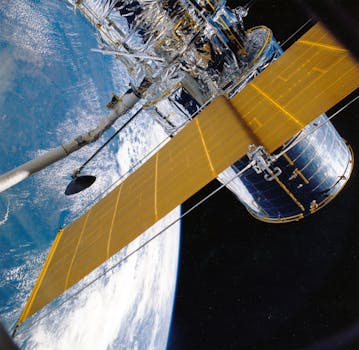From Geostationary to Low Earth Orbit: The Evolution of Satellite Telecommunications in 2023

From Geostationary to Low Earth Orbit: The Evolution of Satellite Telecommunications in 2023
Satellite telecommunications has come a long way since its inception, with significant advancements in technology and infrastructure. The Focus Keyword: Satellite Telecommunications industry has witnessed a paradigm shift in recent years, with a transition from geostationary to low Earth orbit satellites. This evolution has brought about numerous benefits, including improved connectivity, increased efficiency, and enhanced customer experience.
Geostationary satellites, which orbit the Earth at an altitude of approximately 36,000 kilometers, have been the backbone of the satellite telecommunications industry for decades. However, they have several limitations, including high latency, limited bandwidth, and high operational costs. On the other hand, low Earth orbit satellites, which orbit the Earth at an altitude of around 160-2,000 kilometers, offer several advantages, including lower latency, higher bandwidth, and reduced operational costs.
The Advantages of Low Earth Orbit Satellites
Low Earth orbit satellites have several advantages over geostationary satellites. One of the primary benefits is lower latency, which is critical for real-time applications such as video conferencing, online gaming, and virtual reality. Low Earth orbit satellites also offer higher bandwidth, which enables faster data transfer and improved connectivity. Additionally, low Earth orbit satellites are less expensive to launch and operate, making them a more cost-effective option for satellite telecommunications.
Another significant advantage of low Earth orbit satellites is their ability to provide global coverage, including remote and underserved areas. This is particularly important for areas where traditional telecommunications infrastructure is lacking or non-existent. Low Earth orbit satellites can provide connectivity to these areas, enabling access to essential services such as education, healthcare, and finance.
The Challenges of Low Earth Orbit Satellites
While low Earth orbit satellites offer several advantages, they also pose some challenges. One of the primary challenges is the need for a large constellation of satellites to provide global coverage. This can be expensive and complex, requiring significant investment in infrastructure and technology. Additionally, low Earth orbit satellites have a shorter lifespan than geostationary satellites, which can range from 5-10 years, compared to 15-20 years for geostationary satellites.
Another challenge facing low Earth orbit satellites is the risk of interference from other satellites and terrestrial systems. This can be mitigated through careful planning and coordination, but it remains a significant challenge. Furthermore, low Earth orbit satellites require more sophisticated technology to maintain their orbit and ensure continuous connectivity.
The Impact on the Industry
The transition from geostationary to low Earth orbit satellites is having a significant impact on the satellite telecommunications industry. The industry is witnessing a shift towards more agile and flexible business models, with a focus on providing connectivity to underserved areas. The use of low Earth orbit satellites is also enabling the development of new applications and services, such as IoT, 5G, and satellite-based broadband.
The industry is also seeing significant investment in infrastructure and technology, with numerous companies launching new constellations of low Earth orbit satellites. This investment is driving innovation and growth, with the satellite telecommunications market expected to reach $15.5 billion by 2025, growing at a CAGR of 12.3% from 2020 to 2025.
Conclusion
In conclusion, the evolution of satellite telecommunications from geostationary to low Earth orbit satellites is transforming the industry. The advantages of low Earth orbit satellites, including lower latency, higher bandwidth, and reduced operational costs, are making them an attractive option for satellite telecommunications. While there are challenges associated with low Earth orbit satellites, the industry is witnessing significant investment and innovation, driving growth and development.
As the industry continues to evolve, we can expect to see more advanced technologies and applications emerge, enabling faster, more reliable, and more affordable connectivity. The future of satellite telecommunications looks promising, with low Earth orbit satellites playing a critical role in shaping the industry’s future.


